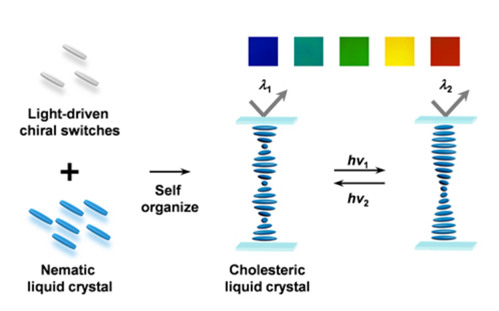Search
Title: Phototuning of Structural Colors in Cholesteric Liquid Crystals
Author: Xiaojun Liu, Lang Qin, Yuanyuan Zhan, Meng Chen, Yanlei Yu*
Journal: Acta Chim. Sinica, 2020, 78(6), 478-489
Abstract:
Cholesteric liquid crystals (CLCs) are a kind of intriguing soft photonic crystal materials, in which the orientation of LC molecules varies in a helical fashion, and selectively reflect light, known as structural color, according to Bragg’s law. Moreover, the structural color determined by the pitch length of the helices in CLCs can be tuned owing to the dynamic control of inherent self-organized helical superstructures in response to external stimuli. Currently, light-driven CLCs have attracted extensive interest because light, compared to other stimuli, has unique advantages of remote, temporal, local, and spatial manipulation. Such elegant systems are generally formulated by doping light-driven chiral switches, mainly consisting of chiral centers and photoswitches, into a nematic LC host. The chiral centers are able to twist the nematic LC host into helical superstructures, which is represented by helical twisting power (HTP). The photoswitches undergo configurational changes upon photoisomerization, leading to the variation in HTP and the pitch length of the helices, and consequently tune the structural color of the CLCs. These light-driven CLCs provide opportunities for various photonic applications such as tunable filters, sensors, tunable optical lasers, and optically addressed displays. In this review, we summarize diverse light-driven CLC systems according to the type of the photoswitch in doped chiral switches. Azobenzene- and motor-based chiral switches usually have high HTP and large variation in HTP, which enables the tuning range of the resultant CLC to cover visible spectrum. Besides, chiral switches based on dithienylethenes have also been synthesized and utilized to tune the reflection of the CLC across red, green, and blue colors that remain unchanged in darkness even after one week because of the excellent thermal stability of dithienylethenes. Chiral switches based on dicyanoethene are used to construct an optically tunable reflective-photoluminescent CLC system. Importantly, the design of the light-driven chiral switches is analyzed in detail to reveal the structure-property correlation. Potential and demonstrated practical applications of light-driven CLCs are discussed, and forecast of existing challenges and opportunities in CLC systems are concluded.
Fulltext Link: http://sioc-journal.cn/Jwk_hxxb/CN/10.6023/A20040103








